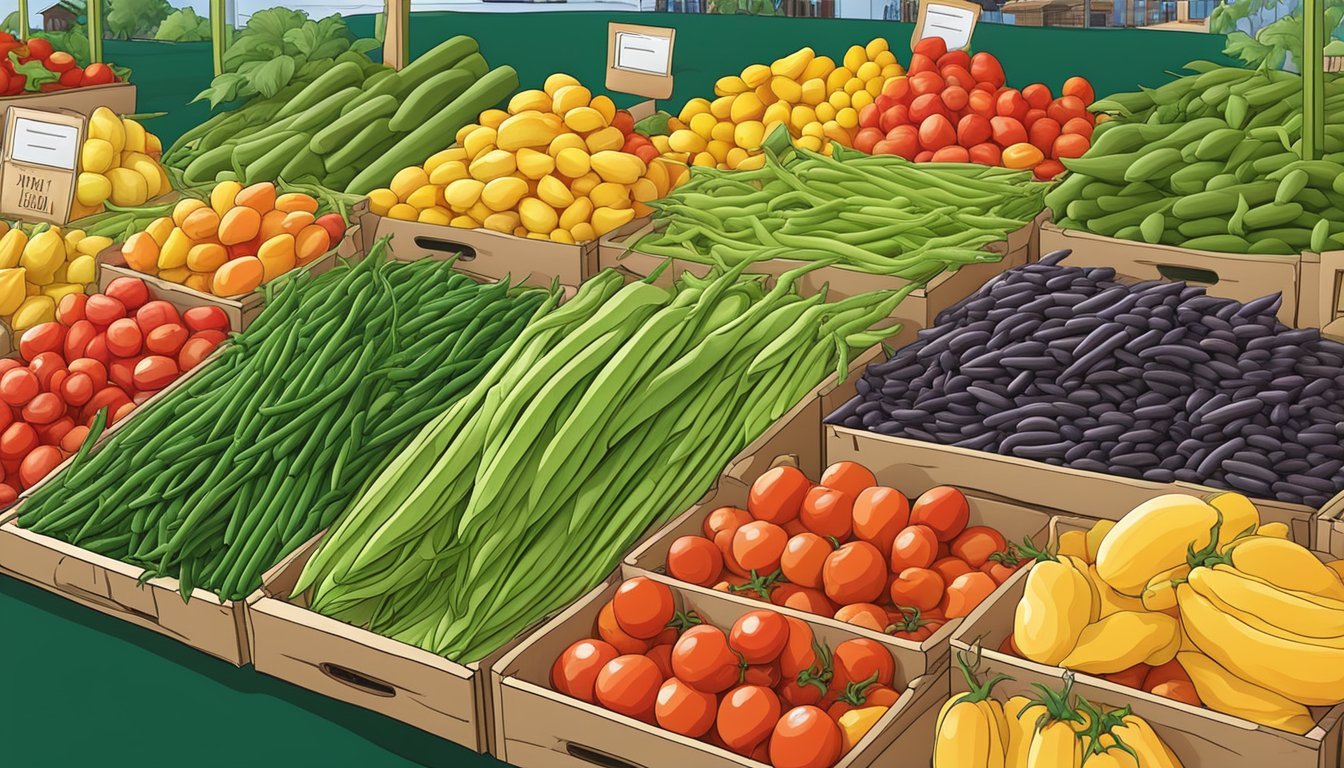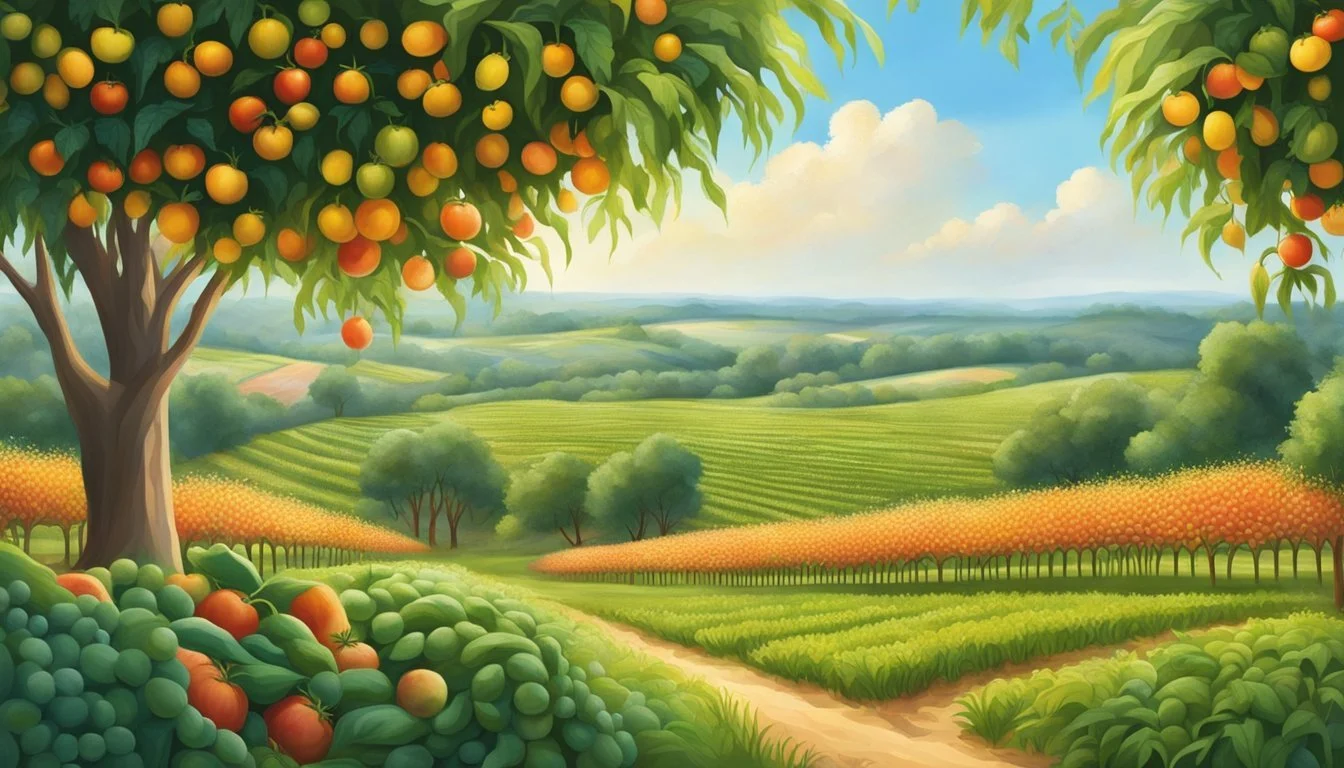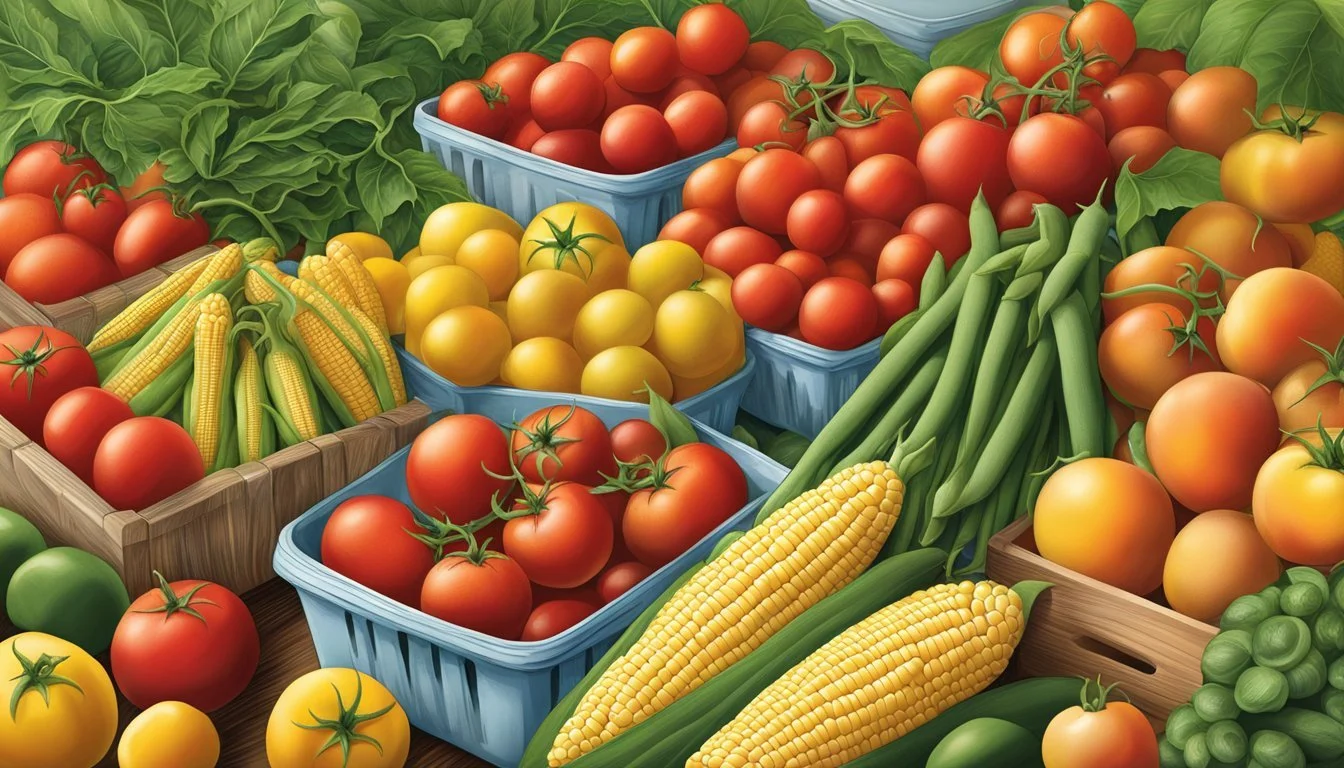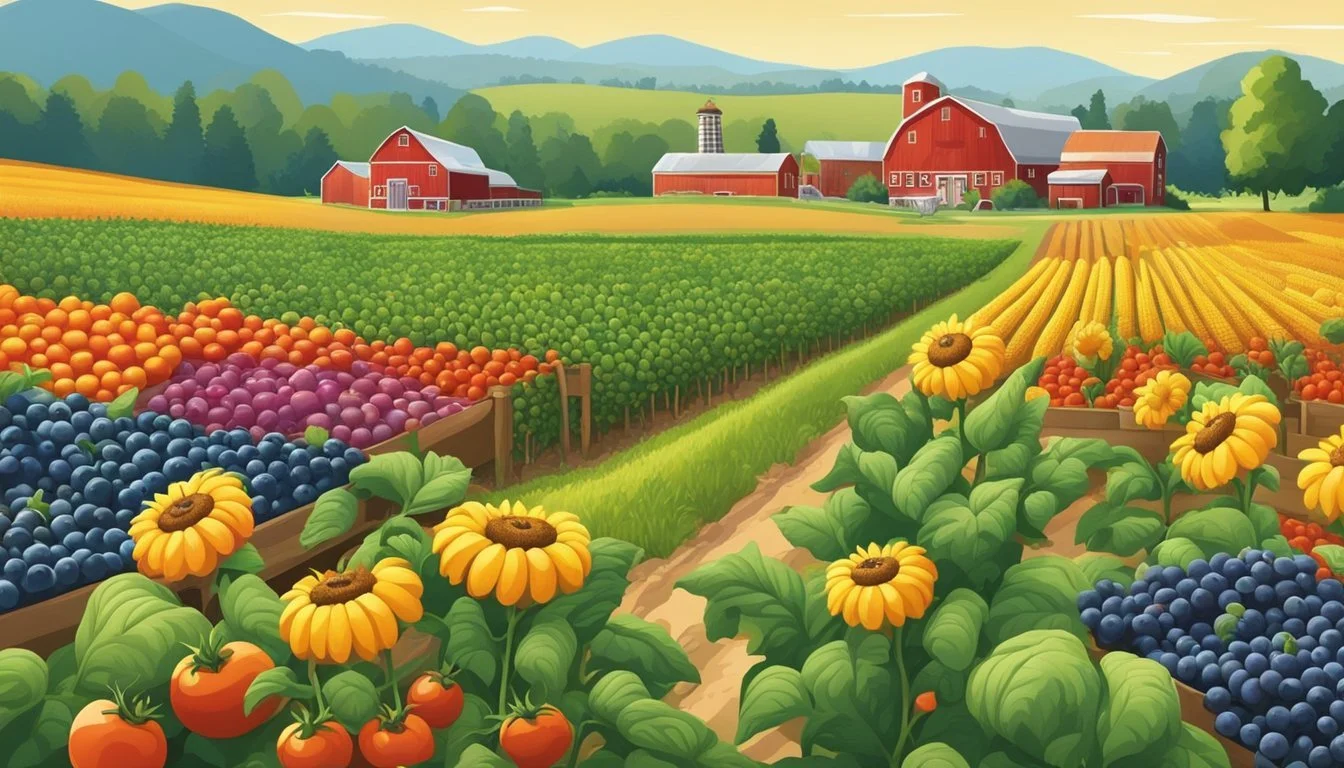Indiana Seasonal Fruit & Vegetables in July
Your Fresh Produce Guide
This Article is Part of our Indiana Seasonal Fruit & Veg Calendar
In Indiana, July marks the peak of summer when the state's farmlands are bountiful with fresh fruits and vegetables. This period offers a cornucopia of produce options due to the region's warm temperatures and fertile soils. Consumers eagerly anticipate the arrival of juicy fruits and lush vegetables that are not only a staple of summer fare but also key components of a healthy diet.
During this month, shoppers at local markets can find a wide array of produce. Fruits like blueberries (how long do blueberries last?), raspberries, blackberries (how long do blackberries last?), and cherries (how long do cherries last?)are ripe and plentiful. Indiana's vegetable offerings are equally diverse, with sweet corn, tomatoes, cucumbers, and zucchinis among the season's best. These homegrown goods are not only fresher but may also provide superior flavor and nutrition compared to off-season alternatives.
Seasonal eating in July supports local agriculture and contributes to the sustainability of Indiana’s food systems. By choosing local and seasonal produce, residents can enjoy the freshest available fruits and vegetables while supporting their regional farmers and economies.
Summer Harvest: Peak Season Produce
In July, Indiana's agricultural offerings reach their zenith, presenting an array of vibrant and luscious produce. This is the time of year when farmers' markets and grocery store shelves brim with the freshest local fruits and vegetables.
Berries Galore
Indiana's summer heat brings about a bountiful berry harvest. Juicy strawberries are reaching the tail end of their peak, while blueberries, blackberries, and raspberries are abundant.
Strawberries: Ideal for jams or fresh eating
Blueberries: High in antioxidants; perfect for pies or by the handful
Blackberries: Large and sweet, used in desserts or salads
Raspberries: Delicate and tart, great in sauces or as garnishes
Stone Fruit Selections
A delight to fruit lovers, the stone fruit season is in full swing. The fleshy peaches, nectarines, and plums offer a sweet and succulent flavor profile, with cherries providing a delightful pop of tartness.
Peaches: Fragrant and juicy, suitable for baking or grilling
Nectarines: Smooth-skinned, eaten raw or used in dishes
Plums: Juicy with a balance of sweet and tart flavors
Cherries: Perfect for eating fresh, or used in baking and preserves
Melons and More
Summer heat means cool, refreshing watermelon and cantaloupe (how long does cantaloupe last?) are in season. These melons are synonymous with summer refreshment, offering hydration and sweetness on hot July days.
Watermelon: Large, juicy, with red to pink flesh
Cantaloupe: Netted skin, with soft orange flesh
Understanding what's in season helps consumers enjoy fruits and vegetables at their best, supporting local agriculture and sustainable practices.
Fresh from the Field: Vegetables in Season
July in Indiana celebrates the peak of summer, bringing a bounty of fresh vegetables directly from the field. The warm weather and long days allow a variety of crops to flourish, ensuring crisp flavors and nutrient-packed produce for the local tables.
Crisp and Leafy Greens
Indiana provides a selection of refreshing leafy greens during July, each with its unique texture and taste.
Lettuce: It reaches its prime this month, with varieties ranging from romaine to butterhead.
Kale: This hearty green is abundant, offering robust flavors and versatile use in salads and cooking.
Arugula: With a spicy kick, it's perfect for a summer salad mix.
Spinach: Continues to be a staple, with its tender leaves ideal for both raw and cooked dishes.
Swiss Chard: Not only nutritious but also adds a colorful punch to any meal with its vivid stems.
Roots and Bulbs
The soil of Indiana nurtures a diverse array of root vegetables and bulbs, known for their earthy flavors (What wine goes well with earthy flavors?) and culinary versatility.
Onions & Garlic: These pungent staples are harvested and add depth to any dish.
Radishes: Add a peppery zest to salads and are often available in a variety of colors.
Turnips & Beets: Offer both their roots and greens for a dual-purpose, with the roots being excellent for roasting or boiling.
Vine-Ripened Varieties
There’s something special about vegetables that ripen on the vine under the Indiana sun, known for their sweetness and rich flavors.
Tomatoes: From cherry to beefsteak, they are just beginning to reach their peak, perfect for sandwiches, salads, or sauces.
Cucumbers: These are in abundance, ideal for refreshing salads or for pickling.
Summer Squash including Zucchini: They are at their tender best and can be enjoyed grilled, sautéed, or baked.
Indiana's Prime Choices for July
Indiana in July bursts with a variety of fresh produce. This month's bounty is particularly rich in legumes and pods, as well as aromatic herbs that can enhance any summer dish.
Legumes and Pods
Corn: In July, Indiana's corn is at its peak. Known for its sweet flavor and tender kernels, it can be found across local farmers' markets.
Green Beans: These crisp beans are fresh and ready to be steamed, boiled, or stir-fried.
Beans: Look for a variety of beans, including navy, pinto, and black beans (how long do black beans last?) which are versatile for many recipes.
Peas: From snow peas to snap peas, they bring a sweet, crisp addition to salads and stir-fries.
Herb Highlights
Basil: July sees an abundance of basil in Indiana. It's perfect for pesto and garnishing summertime dishes.
Cilantro: With its lively and fresh flavor, cilantro is perfect for salsas and as a garnish on a myriad of dishes.
Dill (how long does dill last?): Ideal for pickling and seasoning, fresh dill is a must-have for dishes requiring a tangy zest.
Thyme: This herb imbues dishes with a subtle, earthy flavor that is quintessential in many summer recipes.
Peppers and potatoes are also plentiful during this month, with peppers ranging from sweet to hot varieties, and potatoes providing a staple for grilling or boiling.
Nutritional Benefits and Culinary Uses
In July, Indiana's farms offer a bounty of fruits and vegetables brimming with nutritional benefits and versatile for a range of culinary applications.
Healthy and Nutritious Picks
Fruits like apples, available from July through October, are refreshing and a rich source of antioxidants. These nutrients are crucial in protecting the body from oxidative stress and may contribute to heart health. Vegetables such as cabbage, eggplant (What wine goes well with eggplant?), and broccoli (how long does broccoli last?)are in season and enrich diets with essential vitamins and minerals. Cabbage is low in calories, yet high in fiber and vitamins C and K, making it excellent for digestive health and immunity. Eggplant (What wine goes well with eggplant?) contains a variety of vitamins, minerals, and fiber, and it has been linked to benefits like improved heart health. Broccoli is another powerhouse, offering a high content of vitamins C and K, potassium, fiber, and compounds that may support antioxidant functions and overall health.
Cooking and Preparation Ideas
These seasonal offerings lend themselves to a plethora of dishes. Cabbage can be shredded into salads for a crisp, nutritious addition or slow-cooked to sweet perfection to accompany a rich roast. Eggplant's meaty texture makes it ideal for grilling or baking, and it's often utilized as a hearty main in plant-based meals. Broiled or stir-fried broccoli retains its nutritional integrity and can be a verdant, flavorful side. Indiana's summer fruits inspire countless desserts, from apple crumbles to refreshing honey-sweetened fruit salads. In the realm of beverages, these fruits can be muddled or juiced to create vibrant cocktails and non-alcoholic drinks that embody the essence of summer with every sip.
Preservation and Storage
In Indiana, July's abundant harvest presents the perfect opportunity for preservation. Fruit and vegetables can retain their quality and nutritional value through proper storage methods such as freezing and canning.
Freezing is one of the most accessible preservation methods. It is crucial to blanch vegetables before freezing them to preserve color, flavor, and texture. Blanching involves scalding vegetables in boiling water for a short time and then plunging them into ice water to halt the cooking process. After blanching, individuals can dry the vegetables and pack them in freezer-safe containers or bags.
Fruits, on the other hand, can be frozen without blanching. It's often advised to slice and treat them with ascorbic acid (vitamin C) to prevent browning. Simple syrup or sugar packing can also be handy in preserving the texture and flavor of fragile fruits.
Canning preserves fruits and vegetables by packing them into airtight containers, typically jars, and heating them to a temperature that eliminates spoilage-causing microbes. Two main canning methods are widely used:
Water Bath Canning: Suitable for high-acid foods like fruits and tomatoes.
Pressure Canning: Necessary for low-acid vegetables to prevent the risk of botulism.
When canning, it's imperative to follow tested recipes and guidelines from credible sources, such as the Purdue University Cooperative Extension Service, to ensure safety.
Seasonally fresh produce can be enjoyed throughout the year if they are preserved correctly. Remember, storing produce in cool, dry places or refrigerating them can extend their freshness. However, the shelf life varies widely among different fruits and vegetables and should be considered when planning preservation.
Shopping Locally
In July, Indiana's farmers' markets are bustling with the season's best locally grown produce. Shoppers can find a variety of fruits and vegetables that are both fresh and in peak season.
Farmers Market Finds
At Indiana's farmers' markets in July, one can expect to find an abundant selection of summer fruits and vegetables. Here's a snapshot of what's typically available:
Fruits:
Blackberries: Look for plump, deeply colored berries.
Blueberries: Seek out firm, uniformly sized berries with a light silvery bloom.
Vegetables:
Broccoli: Choose heads with tight, green florets and firm stalks.
Brussels Sprouts: Opt for small, firm, and green sprouts.
Cabbage: Select heads that are dense and heavy for their size.
Carrots: Fresh carrots should be firm and smooth.
Locally grown cantaloupes are also a highlight in July, and shoppers should go for ones that feel heavy for their size with a fragrant smell at the stem end.
Shopping at these markets not only provides access to fresh, nutritious produce but also supports local farmers and the regional economy. It's a chance for consumers to engage with the community and learn more about where their food comes from.
Environmental Impact and Sustainability
Choosing seasonal fruit and vegetables has palpable environmental benefits. By purchasing crops during their natural growing season, consumers support sustainable farming practices that are more in harmony with local ecosystems. Sustainable agriculture often entails using fewer pesticides and fertilizers, which can lead to a decrease in soil and water contamination and promote biodiversity.
Local economies thrive when consumers buy from regional farms. Transportation costs and the associated greenhouse gas emissions are significantly reduced when food doesn't travel long distances. A shorter transit period also means less spoilage and waste, which not only supports the environment but also bolsters the local supply chain's efficiency.
July in Indiana sees a variety of crops in season. For instance:
Vegetables: Tomatoes, Peppers, Cucumbers
Fruits: Blueberries, Raspberries, Melons
Supporting these local, in-season options helps to ensure that Indiana's valuable farmland is maintained and that the community's carbon footprint is minimized. Furthermore, local purchasing encourages farmers to continue with or convert to sustainable practices, knowing there is a market for their produce.
Farmers' markets and community-supported agriculture (CSA) programs are excellent avenues for consumers to participate in these sustainability efforts. They enable direct interaction between the grower and the consumer, which in turn, strengthens the vitality of the local economy.









